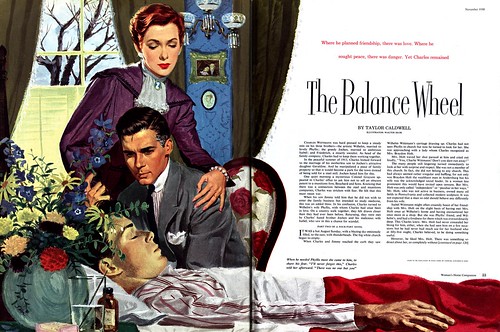
His illustration for the May '52 issue of WHC, however, is another story all together.

By riffing on Piet Mondrian for a background motif, Skor provides us with a perfect example of a number of major changes taking place in illustration at that time: the "big head and hands" element, the elimination of traditional background environment, the reduction of props to only those essential to the story, an emphasis toward flat, graphic areas of colour.
Perhaps most importantly, Skor plainly shows us that illustrators were not oblivious to the world of fine art - and the radical new experiments in abstraction taking place there. Skor could hardly have picked a more ideal fine artist to incorporate into his illustration to evoke a sense of modernity for the WHC reader. Mondrian's bright, bold, angular art seems to have been co-opted in all aspects of popular culture of the day, from packaging to architectural design.
And to return to yesterday's point... Al Parker beat Walter Skor to the idea of incorporating modern art into his illustration by two years.
These images can be seen at full size in my Walter Skor Flickr set.
Hey, Leif,
ReplyDeleteFrom a distance of 50 years you can really see how the illustrators were keeping a close eye on the modernist trends. The Parker show at the Rockwell Museum really drives the point home. Have you checked it out?
There are nice Whitcombs, Lovells, and Whitmores in the show, too, and they must have had a hard time keeping up with Parker's experimentation. Let me add my vote for more on Gannam.
Hey James;
ReplyDeleteThat's a great way of putting it. Yes, and as you know, the modern art movements were thoroughly discussed in the Famous Artists Course (Mondrian gets almost two full pages in my volume) so they really did treat it very seriously, I think.
Unfortunately I did not get to the Parker show... something I'll be kicking myself over for years to come, I know...
Leif, I think your comments are right on the money, and supported by good logical conclusions.
ReplyDeleteAfter talking with Al Parker in 1959, he alluded to the Japanese wood block prints that became popular with some of the French Impressionists. I then became aware of the influence that it must have had on his work.
The stylized Japanese drawings were completely linear, the colors were flat and decorative, and patterns were used to give variety and interest. It was all about color, shapes and design... and little or no depth or dimension to individual elements.
Perhaps that is why Al Parker became the great innovator of illustration... because he was influenced by sources that few illustrators thought about. Specifically, the beautiful oriental designs of the past, integrated with modern American illustration.
In these experimental editorial illustrations, the illustration, headline, caption, and body copy, together became one harmonious design... an exhilarating visual symphony to lure the audience.
Tom Watson
Thanks, Tom - I see a lot of that Japanese woodblock print influence in Monday's piece by Dorothy Monet in particular.
ReplyDeleteWhat's interesting to me is how closely the techniques these artists used come to looking like comic book art ( the Skor piece excepted ) - though we know comics were denegrated at the time.
I doubt they would have welcomed the comparison...
This comment has been removed by a blog administrator.
ReplyDelete